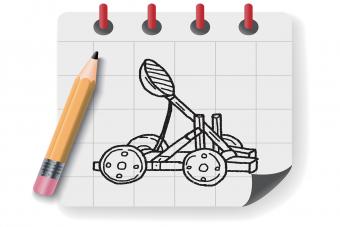
Racing downhill on kids' snow sleds is an all-time favorite winter pastime, and you don't have to be a child to enjoy the fun. Sleds can be as simple as a large sheet of plastic used to slide down the hill or as elaborate as a catamaran with a rider's seat.
About Kids' Snow Sleds
Kids' snow sleds, quite simply, are sliding vehicles usually composed of a flat or rounded piece of plastic, wood, metal or other material. Sleds have runners that lift them above ground level, while toboggans slide across the surface of the snow or ground. While most Americans think of sliding down a snowy hill when they picture a sled, in many countries, sleds are a means of transporting people or hauling freight. Hitch animals, like dogs or reindeer, to the sleds, and the vehicles are sleighs (think Santa).
Types of Sleds
One of the best sleds for kids is the saucer. The kids sit on these round, plastic projectiles and zip down hills. They are lightweight, easy for almost any child to carry or handle, and inexpensive, which makes them popular with adults.
While saucers are a favorite choice, the traditional sled or toboggan is an iconic classic with many families. They are made of plastic or wood and come in a wide variety of styles and colors. Catamarans can be a sled (with runners) or toboggan (without), but they all feature a riding seat made of trampoline material. They furnish a bouncy ride that kids love. Sledders on luges recline and control the sled with their feet and shoulders.
Because it is important to match the size of the sled to your child's height and weight, you may want to shop for a sled at a local store rather than online. In addition to allowing you to let your child sit, stand and handle the sled prior to the purchase, you can usually take it home with you the same day. While ordering online seems convenient, there is the shipping and handling cost to consider, as well as the wait time to receive your sled.
Choosing Sleds and Keeping Safe
Fun winter activities for kids, like sledding, can turn tragic in a heartbeat if some simple safety rules are ignored. Keep everyone safe while sledding by making sure that the chosen location is not too steep and there are no dangerous objects, like trees or huge rocks, in the sledding path. Check to see where the hill terminates, and use the buddy system. Teach them snow safety rules, and make sure even the youngest child understands the importance of following the rules.
When you are considering different types of sleds for your kids, ask yourself some questions like these to help you make the best selection:
- Will your child be able to steer the sled, or it is too large for him to handle?
- Can she carry or drag it back uphill unassisted?
- What are the sled's weight limits as compared to your child's weight?
- How fast will the sled go?
- What happens if the sled overturns? Can your child manage the sled in order to turn it back over?
- Do you want to allow your child to have riders or not?
The answers to these questions not only help you narrow down the selection of a sled from the various options, but they also help you make choices to keep your child safe while sledding.
Taking Care of Your Sled
Your sled maintenance chores will vary slightly depending on whether your sled is plastic, wood or has metal runners. Make the job easier and teach your kids responsibility at the same time by expecting them to help keep their sled clean and well maintained. Just follow these simple steps:
- After every use, check the sled for any damage. If you have a plastic sled that cracks, you may want to consider replacing it, as cracks can slow down a sled.
- Rinse off the sled to get rid of any dirt, debris or chemicals.
- Wipe the sled dry with a soft cloth. If you have a sled with metal runners, it is important to get the runners as dry as possible to prevent rust.
- Store the sled in a dry place until the next use.
Even though plastic sleds are inexpensive and easily replaced, teaching your children to take good care of their kids' snow sleds or any toy vehicle sets a good example for them to follow. Learning to take care of their possessions so they last a long time is a valuable lesson in frugality for any child.







